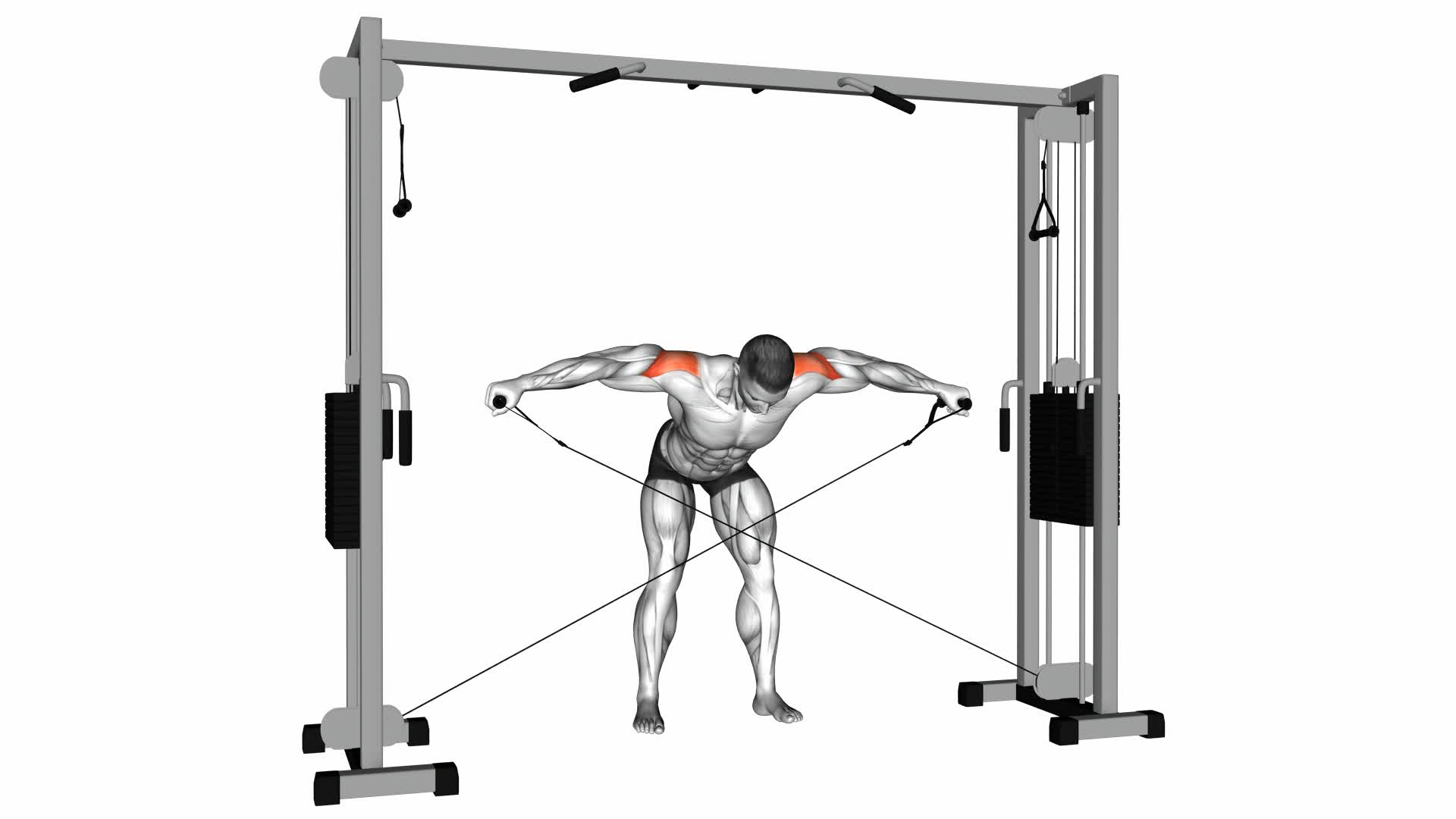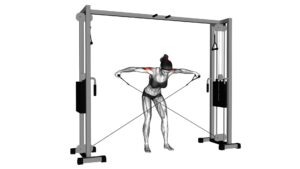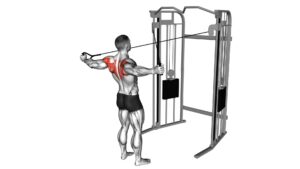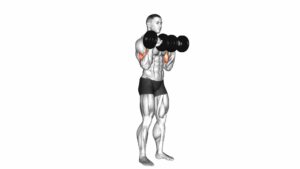Cable Cross-over Revers Fly – Video Exercise Guide & Tips

Looking to strengthen your upper back and shoulders? Check out this video exercise guide for the cable cross-over reverse fly.
Watch This Exercise Video
In just a few minutes, you'll learn the proper technique, common mistakes to avoid, and tips for maximizing your results.
Whether you're a beginner or advanced, this exercise has variations and progressions for all fitness levels.
Get ready to improve your posture and build a stronger upper body with this effective workout.
Key Takeaways
- Targets muscles in upper back, shoulders, and rear delts
- Improves posture and strengthens upper body
- Enhances shoulder stability and mobility
- Helps prevent shoulder injuries
Benefits of Cable Cross-over Reverse Fly
To maximize your workout, incorporate the benefits of performing the cable cross-over reverse fly exercise. This exercise targets the muscles in your upper back, shoulders, and rear delts, helping to improve posture and strengthen the upper body.
One of the key benefits of the cable cross-over reverse fly is its versatility. There are various variations of this exercise that can be performed, allowing you to target different areas of your upper body and add variety to your routine. For example, you can adjust the height of the cables to focus on different parts of your shoulders and back. Additionally, you can change the grip on the handles, such as using an overhand or underhand grip, to engage different muscles.
To incorporate the cable cross-over reverse fly into a full body workout, you can include it as part of your upper body routine or as a compound exercise in a full body circuit. Start by setting the cables at chest height and standing in a staggered stance. Hold the handles with an overhand grip and keep your core engaged.
Begin the movement by squeezing your shoulder blades together and pulling the cables back and out to the sides. Control the movement as you return to the starting position. Aim for 10-12 reps and 2-3 sets, gradually increasing the weight as you get stronger.
Proper Technique for Cable Cross-over Reverse Fly
Mastering the proper technique for the cable cross-over reverse fly is essential for maximizing the benefits of this exercise. To ensure you're performing it correctly, keep the following tips in mind:
- Stand in the center of the cable machine, grasping the handles with an overhand grip.
- Position your feet shoulder-width apart and slightly bend your knees to maintain stability.
- Engage your core and keep a slight bend in your elbows throughout the movement.
Common mistakes to avoid include:
- Using too much weight, which can lead to improper form and potential injury.
- Rounding your shoulders or hunching forward, which reduces the effectiveness of the exercise.
- Swinging your body or using momentum to lift the weights, instead of relying on your muscles to perform the movement.
To add variations and progressions to your cable cross-over reverse fly routine, you can:
- Increase the weight as your strength improves.
- Experiment with different hand positions, such as a neutral grip or underhand grip.
- Incorporate pauses at the top of the movement to further challenge your muscles.
Common Mistakes to Avoid
Avoid these common mistakes when performing the cable cross-over reverse fly to ensure proper form and maximize the benefits for your back and shoulder muscles.
One common mistake is using too much weight. It's important to choose a weight that allows you to maintain control and perform the exercise with proper form. Using excessive weight can lead to improper technique and increase the risk of injury.
Another mistake to avoid is hunching your back or rounding your shoulders. This not only reduces the effectiveness of the exercise but also puts unnecessary strain on your spine and shoulders. Keep your back straight and your shoulders down and back throughout the movement.
Improper positioning of the cables is another common mistake. Make sure the cables are set at chest height and adjusted to a comfortable distance. This will ensure that you can perform the exercise with a full range of motion and target the intended muscles.
Finally, rushing through the exercise is a mistake that many people make. Take your time and focus on the contraction of your back and shoulder muscles during each repetition. This will help you get the most out of the exercise and prevent any potential injuries.
Tips for Maximizing Results
To get the most out of your cable cross-over reverse fly, focus on proper form and incorporating these tips for maximizing results:
- Maintain proper posture: Stand with your feet shoulder-width apart, slight bend in your knees, and engage your core. Keep your back straight throughout the exercise to avoid strain.
- Control the motion: Slowly bring your arms out to the sides, squeezing your shoulder blades together at the peak of the movement. Avoid using momentum or swinging your arms, as this reduces the effectiveness of the exercise.
- Adjust the weight: Start with a lighter weight and gradually increase as you become more comfortable with the movement. Using too heavy of a weight can compromise your form and limit muscle activation.
Maximizing muscle growth requires effective workout strategies. By focusing on proper form, controlling the motion, and adjusting the weight, you can ensure that you're targeting the correct muscles and working them to their full potential.
Incorporate these tips into your cable cross-over reverse fly routine to maximize your results and enhance your overall strength and muscle development.
Variations and Progressions for All Fitness Levels
To further enhance your cable cross-over reverse fly routine and cater to different fitness levels, here are some variations and progressions you can incorporate.
For beginners or those who may have limited shoulder mobility, modification options for the cable cross-over reverse fly can be helpful. Instead of using both arms simultaneously, you can start by performing the exercise with one arm at a time. This allows you to focus on proper form and control before progressing to using both arms.
Another modification option is to decrease the weight or resistance used. This can be achieved by adjusting the weight stack on the cable machine or by using lighter resistance bands. By reducing the load, beginners can gradually build strength and avoid strain or injury.
Precautions for beginners in cable cross-over reverse fly include starting with a lighter weight and focusing on proper form. It's important to maintain a slight bend in the elbows throughout the exercise and avoid using excessive momentum. Engage your shoulder blades and squeeze them together at the top of the movement.
As you progress in your fitness journey, you can increase the weight or resistance used to challenge your muscles further. You can also experiment with different variations, such as performing the exercise on an incline bench or using a single-arm cable machine. These variations target different muscles and add variety to your routine.
Remember to always listen to your body and adjust the intensity and difficulty of the exercise according to your fitness level. As with any exercise, consult with a qualified fitness professional if you have any concerns or questions.
Frequently Asked Questions
What Are Some Alternative Exercises That Target the Same Muscle Groups as the Cable Cross-Over Reverse Fly?
If you're looking for alternative exercises that target the same muscle groups as the cable cross-over reverse fly, there are a few options to consider.
One exercise is the bent-over dumbbell row, which works the muscles of the upper back and shoulders.
Another option is the seated cable row, which also targets the same muscle groups.
Additionally, you can try the bent-over barbell row as another alternative exercise to engage these muscle groups effectively.
How Many Sets and Repetitions Should I Perform for the Cable Cross-Over Reverse Fly?
To properly perform the cable cross-over reverse fly, start by standing in the center of the cable machine with your feet shoulder-width apart.
Grab the handles and extend your arms in front of you. Keep a slight bend in your elbows and pull the cables out to your sides, squeezing your shoulder blades together.
Avoid swinging your body or using momentum.
Aim for 3-4 sets of 10-12 repetitions, focusing on controlled movements and maintaining good form.
Can I Perform the Cable Cross-Over Reverse Fly Without a Cable Machine?
Yes, you can perform the cable cross-over reverse fly without a cable machine. There are alternative equipment options available, such as resistance bands or dumbbells.
However, it's important to note that the cable machine offers unique benefits for this exercise, such as constant tension throughout the movement and the ability to target specific muscle groups.
Nevertheless, if you don't have access to a cable machine, you can still work on strengthening your back and shoulders using other equipment.
Is It Necessary to Use a Specific Grip While Performing the Cable Cross-Over Reverse Fly?
When performing the cable cross-over reverse fly, it's important to use a specific grip to target different muscles. By changing your grip, you can work different areas of your back and shoulders.
Experiment with a wide grip, narrow grip, or neutral grip to see which variation feels best for you. Remember to maintain proper form and technique throughout the exercise to maximize results and minimize the risk of injury.
Can Beginners Incorporate the Cable Cross-Over Reverse Fly Into Their Workout Routine?
Yes, beginners can definitely incorporate the cable cross-over reverse fly into their workout routine. To modify the exercise for beginners, start with lighter weights and focus on mastering the proper form and technique.
This exercise targets the rear deltoids, helping to improve posture and shoulder stability. By incorporating the cable cross-over reverse fly into your routine, you can strengthen your upper back and shoulders, leading to better overall upper body strength and muscle definition.
Conclusion
In conclusion, the cable cross-over reverse fly is a highly effective exercise for targeting the muscles in your upper back and shoulders. By following the proper technique and avoiding common mistakes, you can maximize your results and achieve a stronger and more defined upper body.
Remember to start with a weight that challenges you and gradually increase as you progress. With variations available for all fitness levels, this exercise can be tailored to suit your individual needs and goals.

Author
Years ago, the spark of my life’s passion ignited in my mind the moment I stepped into the local gym for the first time. The inaugural bead of perspiration, the initial endeavor, the very first surge of endorphins, and a sense of pride that washed over me post-workout marked the beginning of my deep-seated interest in strength sports, fitness, and sports nutrition. This very curiosity blossomed rapidly into a profound fascination, propelling me to earn a Master’s degree in Physical Education from the Academy of Physical Education in Krakow, followed by a Sports Manager diploma from the Jagiellonian University. My journey of growth led me to gain more specialized qualifications, such as being a certified personal trainer with a focus on sports dietetics, a lifeguard, and an instructor for wellness and corrective gymnastics. Theoretical knowledge paired seamlessly with practical experience, reinforcing my belief that the transformation of individuals under my guidance was also a reflection of my personal growth. This belief holds true even today. Each day, I strive to push the boundaries and explore new realms. These realms gently elevate me to greater heights. The unique combination of passion for my field and the continuous quest for growth fuels my drive to break new ground.







